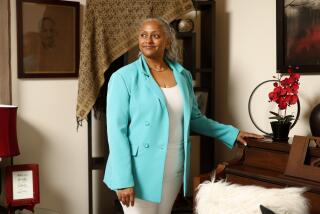The Old Drawing Board Gets High-Tech Slant
People who work at advertising agencies used to be paid to doodle. Sometimes they used pencils. More often it was with felt-tip pens.
But few ad people doodle any more. They compute.
At advertising agencies from Madison Avenue to Madison, Wis., personal computers are quickly replacing the drawing boards that artists used to keep at their desks. Today, artists are creating ads--particularly print ads--right on their PCs. And if they don’t like what they’ve created, they can change it all faster than you can sharpen a No. 2 pencil.
“At first, it’s very intimidating,” said Mel Abert, executive vice president of the Los Angeles ad firm Abert Newhoff & Burr. “You lay out some ad, you give the computer instructions to do something, and you end up losing what you’ve done before. That’s a very frightening experience.”
But it certainly didn’t frighten his agency away from installing tens of thousands of dollars worth of new computers over the past few months. And Abert, whose agency creates ads for Yamaha motor scooters, figures that eventually he’ll chuck his drawing board.
“If a guy like me can sit down and learn this stuff,” said the 47-year-old Abert, “anyone can.”
In fact, just about everyone is. Especially in Southern California. Just five years ago, the concept was still on the drawing boards, so to speak. But industry consultants say that since these specialized personal computers were introduced about five years ago--particularly the Macintosh computer by Apple Computer--virtually every major ad agency in Los Angeles now has its artists creating ads on PCs.
“Eventually,” said Jonathan Seybold, publisher of two newsletters on the personal computer industry, “every artist at every advertising agency will have a computer on their desk.”
Of course, computers come with hitches. They are costly--up to $10,000 each when all the accessories and software are added. Then there are the consultants who make anywhere from $25 to $100 per hour teaching artists how to use them. Some traditionalists wonder if the ads created on computers somehow lose the personal touch of the individual artist. And on top of everything else, personal computers are turning inside out the way ad agencies have operated for decades.
“People tell me they come to my classes just so they can keep their jobs,” said Bruce Kaplan, who owns a Los Angeles consulting firm, Mind Over Macintosh, and who teaches computer graphics classes at UCLA Extension.
The growing use of PCs “is changing the whole structure of creative and production departments,” said Kaplan. Many agency art directors would formerly draw very loose designs of ads and then hand them off to production artists to complete. Now they are producing far more exact designs on their personal computers. Said Kaplan, “This is especially good for the art directors who always thought they could do it better themselves.”
The man who is generally regarded as one of the most talented creative directors in America, Lee Clow, agrees that the use of personal computers to create ads is the wave of the future. But it is a future that Clow, president of the Venice ad agency Chiat/Day/Mojo, is still not prepared to fully embrace.
“Ultimately,” he said, “it has to be a blend of the old way and the new.”
Sure, Chiat/Day/Mojo has dozens of personal computers. And when it used to create ads for client Apple Computer, it was among the very first ad firms in the country to place personal computers on the desks of its artists. After all, it got them at virtually no cost. But while the younger artists are generally quick to pick up on the computer skills, Clow said some of the veterans are shying away. And Clow, 46, counts himself among them.
Earlier this month, Clow created a self-promotion ad for his agency that ran in several major newspapers. “I doodled that on a piece of paper,” said Clow. “I could have done it on a Macintosh, but it would have taken me three times as long.”
Of course, computer experts and consultants insist that with enough instruction, Clow probably could have done it three times as fast.
“When I had my own ad agency,” said Bertram Gader, who now teaches agency professionals how to use personal computers, “I’d have given the first joint off the pinky on my drawing hand to have such a thing as a personal computer.”
For nearly three years, Gader--who lives in Hollywood and was formerly art director at his agency--has made a decent living telling artists how to create ads on personal computers. “I don’t even mention the word computer,” said Gader. “I call it the ultimate Magic Marker.”
All day Saturday, for example, he held a workshop with a handful of artists from the Los Angeles office of Grey Advertising. Just one year ago, Grey’s creative department didn’t have a single PC. Today, every art director at the agency has one, and layouts for all print ads are being created on the machines. Also, many story boards for its TV commercials--a series of sketches that show the key parts of TV ads--are also now produced on personal computers.
“A computer doesn’t make you more creative,” said Miles J. Turpin, chairman and chief executive of Grey Advertising’s Western Division. “It just helps your creative people examine more options.” Over the past year, his agency has spent more than $260,000 on the new personal computers--and that doesn’t include the thousands of dollars for the software that goes into them.
One of the agency’s biggest clients is Lucky Stores, and the huge grocery store chain requires vast numbers of ads--but often with lots of last-minute changes. The personal computer, said Turpin, “allows an art director to try out 50 ideas in the same amount of time that he might try 10 on a drawing board.”
It isn’t just the big agencies that are catching on. In fact, some say that smaller ad agencies are embracing computers even faster than the big guys. For example, the Los Angeles agency Arlen Advertising has just 10 employees and annual billings under $12 million. But one of its clients is Sizzler Restaurants International, for which it creates numerous print ads for Sizzler franchisees.
For Sizzler alone, Arlen creates up to 35 print ads and recruitment brochures every week. “Without the computer,” said Arlen, “we could never handle a piece of business like that.”
Just how important have personal computer skills become for ad agency artists?
Well, about a year ago, one of the largest agencies in Los Angeles purchased a personal computer for its art department. When Gader was called in to consult several of the firm’s top creative artists, he found them utterly disinterested. But there was one young man--who worked in the agency’s mail room--who sat in on most of the classes. What’s more, the mail clerk, who was in his early 20s, took home PC literature to read each evening.
Several weeks later, when the two top art directors were stumped over how to complete an ad layout, the mail clerk walked over to the computer and showed them how to do it.
“Needless to say,” said Gader, “that kid is no longer in the mail room.”
Ad Firm for Lexus Gets a New Driver
Next week, Lexus, the upscale division of Toyota, will begin to air its first ads on national television. But on Monday, just days before the commercials are scheduled to air, the Los Angeles ad agency that created them named a new president.
The man who will take over the reins at the ad agency Team One is John Hirschboeck, 42, who was formerly executive management director in the Torrance office of Saatchi & Saatchi DFS/Pacific.
Senior management at Saatchi & Saatchi, which oversees Team One, said it decided to wait until the initial ad campaign was launched before filling the post of president at Team One. The position has been vacant for nearly seven months. David Wager, who formerly held the post, was recruited last year as a vice president and director of marketing at Porsche of North America.
“We felt to bring in a new president in the middle of the game would be an unnecessary disruption,” said James Linsey, chairman and chief executive of Saatchi & Saatchi DFS/Pacific.
The ad slogan for Lexus, by the way, is: “The relentless pursuit of excellence.” And that is exactly what Team One now says it will chase. Until now, Team One has had only Lexus as a client. But it will now enter the hunt for other clients with “upscale” products, such as clothing and consumer electronics makers. Explained Linsey, “We’ve learned a little bit about those customers while working on Lexus ads.”
Eye-Catching Signs Feature Naked Thighs
Try this one on for thighs.
Several hundred eye-catching billboards that show a sensual set of female thighs began to spring up several weeks along Los Angeles area freeways. The billboard ads are for a $79 rotating shower massage that is advertised to help remove cellulite.
The billboard ad, which shows a woman washing with the device, says, “Treat cellulite like dirt.”
Behind this campaign is Epi Products, a Santa Monica distributor of various health and beauty products. The $300,000 billboard campaign was created by Robert McKim Advertising of Los Angeles. “We wanted to have the ads be essential and sensual,” said Robert McKim, president of the agency. “We think they’re tastefully done. Certainly there’s no suggestion of anything bizarre in them.”
Some of the billboards have already attracted graffiti. And Ed Gottlieb, director of marketing at Epi, said he doesn’t mind that the billboards are somewhat provocative. In fact, he said: “We’re counting on it.”.
One of the area’s largest billboard company’s, Patrick Media Group, said it hasn’t had many complaints about the ads--yet. “The general public is not as easily shocked as it used to get by ads like this,” said Bruce Willoughby, vice president of sales at the billboard company. “If you see a girl in her bikini, you see a heck of a lot more than you see in this ad.”
Even Yosemite Park Sometimes Needs Ads
Why would Yosemite National Park ever need to advertise?
Its lodging facilities are booked many months in advance every summer. And on winter weekends, skiers and hikers descend on the park.
But Yosemite can’t seem to attract many visitors during winter weekdays. So last month, the park hired the San Francisco office of Livingston & Co., a Seattle ad agency, to create a new ad campaign aimed at winter visitors. Yosemite’s $500,000 annual ad budget was previously handled by the Los Angeles office of Foote, Cone & Belding.
“We actually want to un-sell three-fourths of the product,” said Roger Livingston, president of the ad agency. “They’re booked all summer, fall, spring and on weekends.”
But there’s one place Livingston won’t be able to sell Yosemite. The National Park Service won’t allow any of the nation’s parks to be promoted on outdoor billboards.
More to Read
Inside the business of entertainment
The Wide Shot brings you news, analysis and insights on everything from streaming wars to production — and what it all means for the future.
You may occasionally receive promotional content from the Los Angeles Times.










